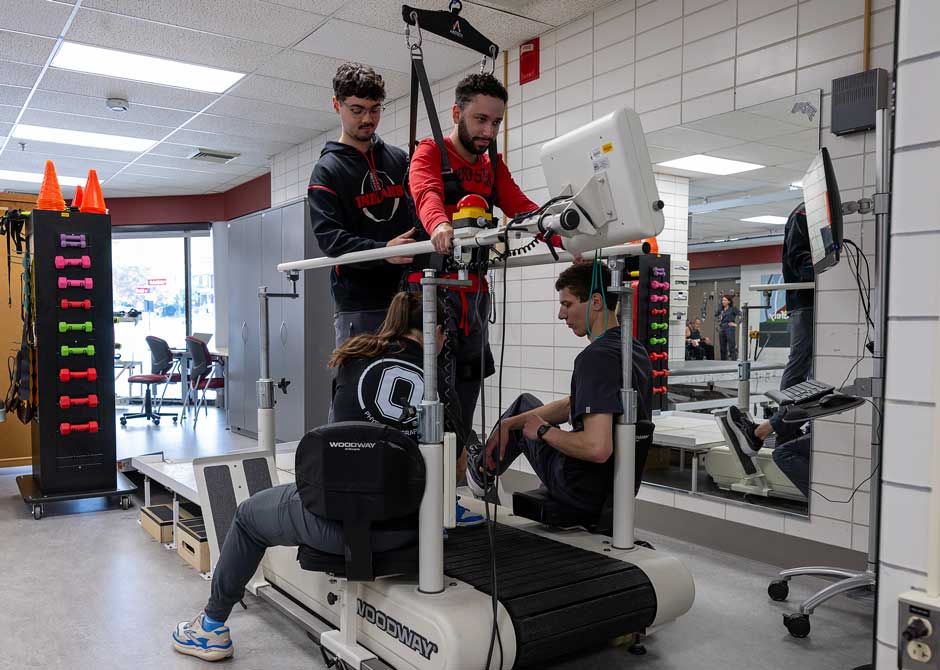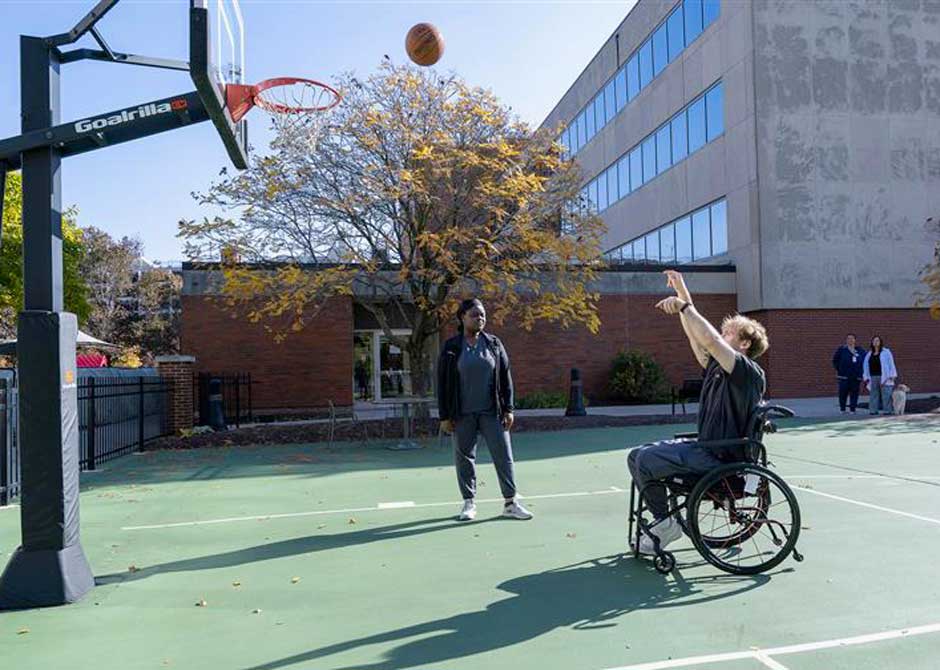 If you have a spinal cord injury or disease that causes total or partial loss of sensation or movement, it can be overwhelming and challenging to know where to turn next for help. If you’re a family member whose loved one sustained a traumatic spinal cord injury, you might feel helpless or hopeless.
If you have a spinal cord injury or disease that causes total or partial loss of sensation or movement, it can be overwhelming and challenging to know where to turn next for help. If you’re a family member whose loved one sustained a traumatic spinal cord injury, you might feel helpless or hopeless.
The Spinal Cord Injury Rehabilitation Program at The Ohio State Wexner Medical Center in Columbus, Ohio, is home to Physical Medicine and Rehabilitation experts who have dedicated their careers to helping people like you. These specialists can work with you to regain function and independence, as well as to cope with any disabilities. We’re the perfect partner in your rehabilitation journey, and we’ll be with you, providing personalized and comprehensive care to meet your needs and goals.
What is the Spinal Cord Injury Rehabilitation Program?
With the latest treatments, therapies, technology and groundbreaking research, our nationally known rehabilitation program is led by a team determined to help you reach your fullest potential.
The shared goal of our team of spinal cord injury rehabilitation experts is to help you regain lost function and skills or learn alternative ways to compensate for what you can’t recover.
Whether you’re navigating a long-term condition or recovering from a recent spinal cord injury, you’ll find compassionate support and personalized care in our inpatient rehabilitation program at Dodd Rehabilitation Hospital, or in our outpatient services located conveniently throughout central Ohio.
At the Ohio State Wexner Medical Center, we recognize that every spinal cord injury is different, and we tailor our treatment plans to your unique spinal disease or condition.
Who is a candidate for spinal cord injury rehabilitation?
We treat people with different types of spinal cord injuries or diseases that have damaged the spinal cord. People with a spinal cord injury typically fall into one of two classifications:
- Complete injury: No function below the level of injury, including no sensation or movement (paralysis) on both sides of the body.
- Incomplete injury: Some movement or sensation below the injury, which may include more function on one side of the body than the other.
Types of spinal cord injuries treated
Damage to the spine can happen for a variety of reasons. In the Spinal Cord Injury Rehabilitation Program, we care for spinal cord injuries caused by:
- Birth injuries
- Falls
- Motor vehicle accidents
- Sports or recreation injuries
- Violent acts
- Strokes or bleeds of the spinal cord
- Diseases, such as cancer, arthritis, inflammation or infection
- Other spinal cord injuries
Spinal cord injury symptoms we help manage
People who enter our Spinal Cord Injury Rehabilitation Program may experience one or more of these issues:
- Tetraplegia (total or partial loss of movement of both arms/hands and legs/feet)
- Paraplegia (total or partial loss of movement of both legs/feet)
- Total or partial loss of feeling in the arms/hands and/or legs/feet
- Difficulty with bladder and bowel function
- Problems with temperature, blood pressure and heart rate control
- Muscle spasms or spasticity
- Pain
- Breathing and swallowing difficulties
- Cognitive difficulties (traumatic or other type of brain injury)
We provide comprehensive care for other medical conditions in addition to a spinal cord injury, including:
- Diabetes, hypertension, heart, lung or liver disease
- Kidney disease that requires dialysis
- Complex organ transplants
- Strokes and other diseases of the brain and spinal cord
- Cancer
As a multidisciplinary spinal cord injury rehabilitation center, we’re able to treat each person holistically. Everyone we treat also has access to hundreds of specialists across the Ohio State Wexner Medical Center for any medical and mental health needs related to a spinal cord injury.
Outstanding outcomes for spinal cord injury rehabilitation
Unparalleled experience
The spinal cord injury rehab program served 133 people with inpatient services at Dodd Hospital in 2024, and 155 people with outpatient services.
Finding the right spinal cord injury rehab
The spinal cord injury program offers services to support each phase of your rehabilitation, from inpatient spinal cord injury rehabilitation to outpatient services once you return home. Continuous care from our team of spinal cord injury experts will help you reach your highest level of recovery.
Our team of health care professionals works together to offer a wide range of rehabilitative services, beginning at the time of injury through rehabilitation and long-term care.
Our services support all levels of need:
- Acute rehabilitation: Short-term medical treatment while you’re admitted to a hospital floor at the Ohio State Wexner Medical Center
- Inpatient rehabilitation: Intensive therapies in Dodd Rehabilitation Hospital
- Outpatient rehabilitation: Follow-up therapy services after you return home from the hospital or another rehabilitation facility
Your care doesn’t stop when you leave the hospital. We also provide community reintegration programs, peer support and follow-up care to help you transition smoothly back into daily life and your community.
What services are included in the Spinal Cord Injury Rehabilitation Program at Ohio State?

Your rehabilitation plan is tailored to your specific needs, goals and level of injury. The shared goal for everyone is to support you and your family to restore as much independence and quality of life as possible.
Technology for spinal cord injury
- Adaptive technology and assistive devices: Wheelchairs, braces and special computer equipment, including technology to support at-home and work activities
- Gait-training systems: Devices including harnesses, treadmills and sensors that will monitor and guide movements as you regain strength and balance in lower limbs
- Bioness® technology: Patented electrical stimulation medical devices designed to help people gain mobility and function
- Functional electrical stimulation: Emits low levels of electrical current to stimulate physical or bodily functions lost through paralysis
- Neuromodulation: Neurological pacemakers and other devices that deliver electrical signals, medications and other therapeutic agents precisely into the brain, spinal cord and nervous system
- SaeboFlex® technology: A patented hand orthotic that helps maximize your arm and hand function following a neurological injury or condition
Testing and training for spinal cord injury
- Augmentative communication assessment and training to determine communication needs, appropriate aids and techniques
- Bladder, bowel, and skin care management to support your overall health and prevent complications
- Caregiver training
- Case management, and coordination of inpatient and post-hospital care and services, for patients and families
- Counseling
- Driving training
- Neurological diagnostic tests, such as CT scans, MRIs and EMGs
- Neuropsychological evaluations to measure concentration, learning and other skills
- Rehabilitation psychology to support you and your family as you cope with a spinal cord injury, chronic pain and disability
- Real-world simulations, such as community reentry and independent living apartment
- Return-to-work training
- Patient education focused on lifestyle adjustments
- Videofluoroscopy, a fiber-optic endoscopic evaluation for swallowing, and neuromuscular electrical stimulation, to diagnose and treat swallowing disorders
Therapies for spinal cord injury
- Aquatic therapy: Rehabilitation exercises performed in a warm-water therapeutic pool
- Arts therapy: Uses the creative process to help you improve physical skills, thinking skills and emotional well-being
- Cognitive therapy: Supports thinking and understanding skills
- Locomotor training: Physical therapy using a suspended harness over a treadmill, while specially trained therapists move your legs to simulate walking
- Occupational therapy: Support for your activities of daily living, including real-world simulations, and to help you regain skills, including those for self-care, cooking and returning to work or school
- Optokinetic training: Exercises to increase your visual field and perception
- Physical therapy: Strength training and manual techniques to improve strength, mobility and fitness, and to treat muscle stiffness or contractures
- Recreational therapy: Support and adaptations to help you engage in leisure activities that enhance your community participation and well-being
- Respiratory therapy: Treatment for breathing disorders using respirators or aerosol medications
- Speech therapy: Treatment of speech and communication disorders, as well as swallowing
- Vestibular therapy: An exercise-based program that helps improve balance
- Vision therapy: Exercises to improve vision and brain issues
Treatments and medications for spinal cord injury rehabilitation
- Advanced splinting: Splints applied to wrists, hands, ankles and feet to help lengthen muscle groups and prevent deformity
- Botox®: Reduces spasticity and tightness in specific muscle groups
- Medications: Treatment for cognitive, communication and motor skill recovery
- Pain management: Treatments to alleviate or reduce pain
- Serial casting: Casts are reapplied for contracture management to stretch and maintain new, lengthened positions of hyperactive muscle groups.
Why choose Ohio State for spinal cord rehabilitation?
Our spinal cord rehabilitation center consistently ranks among the best in the nation. As an academic medical center, we offer medical expertise, innovative care backed by research, and the most advanced technology and treatment.
Here’s why people choose Ohio State to help them recover from a spinal cord injury or condition:
Personalized care: Your recovery journey at Ohio State is based on a personal evaluation and individualized care plan to meet your needs and guide you toward your health goals. You’ll gain the skills you need to improve your abilities at work, at home and in social settings.
Best-in-class outcomes: Our treatment plans address the specific physical, social, psychological, emotional and financial issues that often accompany spinal cord injuries. For example, our inpatient length of stay is shorter than the national average, helping you return to your community sooner than most rehabilitation programs.
Accredited programs: We are proud that our inpatient rehabilitation programs at Dodd, and our outpatient medical rehabilitation programs, are accredited by the Commission on Accreditation of Rehabilitation Facilities (CARF). CARF recognizes our programs as meeting the highest standards in quality, safety and outcome measures, which provides risk reduction and accountability to our patient care.
Advanced research: From advanced rehabilitation programs to clinical trials exploring new ways to restore movement and independence, we’re committed to giving you access to tomorrow’s medicine, today.
Your spinal cord injury rehabilitation treatment team
Your personalized treatment care plan starts with a team of rehabilitation specialists, including:
- Physical medicine and rehabilitation physicians, or physiatrists, who specialize in helping people regain bodily functions lost due to medical conditions or injuries
- Neurologists specializing in nervous system disorders
- Neurosurgeons specializing in surgery on the brain and other parts of the nervous system
- Neuropsychologists specializing in the effects that injury or diseases of the brain and spinal cord have on emotions, behavior and learning
- Certified rehabilitation nurses specializing in the care of the chronically ill and injured
- Physical therapists specializing in helping patients achieve maximum strength, balance and mobility after a spinal cord injury
- Occupational therapists specializing in improving your ability to complete activities of daily living
- Speech-language pathologists specializing in helping you improve communication, cognition and swallowing
- Recreational therapists specializing in education and community-based interventions to improve your physical, mental, social and emotional well-being
- Respiratory therapists specializing in assessing and treating breathing disorders
- Dietitians who specialize in nutrition and dietetics
- Social workers specializing in the social, emotional and financial needs of families and patients
- Case managers who focus on coordinating inpatient and post-hospital care and services
- Rehabilitation engineers specializing in assistive technology devices, such as wheelchairs, special computer workstations and remote-control systems, who will determine what is best for your condition and train you to use them
